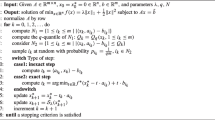Abstract
For many popular stochastic approximation algorithms, such as the stochastic gradient method and the simultaneous perturbation stochastic approximation method, the practical gain sequence selection is different from the optimal selection, that is theoretically derived from asymptotical performance. We provide formal justification for the reasons why we choose such gain sequence in practice.


Similar content being viewed by others
References
Bangerth, W., Klie, H., Matossian, V., Parashar, M., & Wheeler, M. F. (2006). An autonomic reservoir framework for the stochastic optimization of well placement. Cluster Computing, 8(4), 255–269.
Cao, X. (2011). Preliminary results on non-bernoulli distribution of perturbations for simultaneous perturbation stochastic approximation. In Proceedings of the American control conference, 29 June–1 July 2011, San Francisco, CA (pp. 2669–2670) (paper ThB10.6).
Fu, M. C. (1994). Optimization via simulation: A review. Annals of Operations Research, 53, 199–247.
Horn, R. A., & Johnson, C. R. (1985). Matrix analysis. Cambridge: Cambridge University Press.
Hutchison, D. W., & Spall, J. C. (2009). Stopping small-sample stochastic approximation. In Proceedings of American control conference, St. Louis, MO, 10–12 June, 2009.
Kushner, H., & Yin, G. (2003). Stochastic approximation and recursive algorithms and application. New York: Springer.
Maryak, J. L., & Spall, J. C. (2005). Simultaneous perturbation optimization for efficient image restoration. IEEE Transactions on Aerospace and Electronic Systems, 41(1), 356–361.
Rubinstein, R. Y., & Kroese, D. P. (2007). Simulation and the Monte Carlo method. Wiley series in probability and statistics.
Schwartz, J. D., Wang, W., & Rivera, D. E. (2006). Simulation-based optimization of process control policies for inventory management in supply chains. Automatica, 42(8), 1311–1320.
Spall, J. C. (1992). Multivariate stochastic approximation using simultaneous perturbation gradient approximation. IEEE Transactions on Automatic Control, 37(3), 332–341.
Spall, J. C. (1998). Implementation of the simultaneous perturbation algorithm for stochastic optimization. IEEE Transactions on Aerospace and Electronic Systems, 34(3), 817–823.
Spall, J. C. (2003). Introduction to stochastic search and optimization: Estimation, simulation, and control. Hoboken, NJ: Wiley.
Spall, J. C. (2012). Cyclic seesaw process for optimization and identification. Journal of Optimization Theory and Applications, 154(1), 187–208.
Author information
Authors and Affiliations
Corresponding author
Rights and permissions
About this article
Cite this article
Wang, Q. Analysis of practical step size selection in stochastic approximation algorithms. Ann Oper Res 229, 759–769 (2015). https://doi.org/10.1007/s10479-015-1785-9
Published:
Issue Date:
DOI: https://doi.org/10.1007/s10479-015-1785-9




